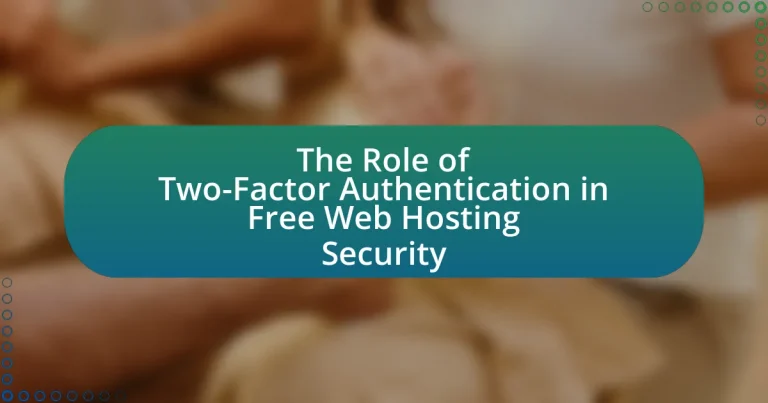Two-Factor Authentication (2FA) plays a crucial role in enhancing security for users of free web hosting services by requiring two forms of verification before account access. This article examines how 2FA mitigates risks such as unauthorized access and data breaches, particularly in environments vulnerable to cyberattacks. Key components of 2FA, including methods like SMS and app-based verification, are discussed, along with best practices for effective implementation. The article also highlights the importance of combining 2FA with additional security measures to create a robust defense against potential threats.

What is the Role of Two-Factor Authentication in Free Web Hosting Security?
Two-Factor Authentication (2FA) enhances security in free web hosting by requiring users to provide two forms of verification before accessing their accounts. This additional layer of security significantly reduces the risk of unauthorized access, as even if a password is compromised, the second factor—often a temporary code sent to a mobile device—remains secure. According to a study by Google, implementing 2FA can block 99.9% of automated attacks, demonstrating its effectiveness in safeguarding sensitive information on free web hosting platforms.
How does Two-Factor Authentication enhance security in free web hosting?
Two-Factor Authentication (2FA) enhances security in free web hosting by requiring users to provide two forms of verification before accessing their accounts. This additional layer of security significantly reduces the risk of unauthorized access, as even if a user’s password is compromised, an attacker would still need the second factor, typically a code sent to a mobile device or generated by an authentication app. According to a study by Google, implementing 2FA can block 99.9% of automated attacks, demonstrating its effectiveness in protecting sensitive information and maintaining account integrity in free web hosting environments.
What are the key components of Two-Factor Authentication?
The key components of Two-Factor Authentication (2FA) are something you possess and something you know. The first component, something you possess, typically refers to a physical device such as a smartphone or a hardware token that generates a time-sensitive code. The second component, something you know, usually involves a password or PIN that the user must enter. This dual-layer approach significantly enhances security by requiring both elements for successful authentication, thereby reducing the risk of unauthorized access. According to a study by Google, implementing 2FA can block up to 99.9% of automated attacks, demonstrating its effectiveness in protecting user accounts.
How does the implementation of Two-Factor Authentication work in practice?
The implementation of Two-Factor Authentication (2FA) in practice requires users to provide two distinct forms of identification before accessing their accounts. Initially, users enter their username and password, which serves as the first factor, something they know. Subsequently, they must provide a second factor, typically a temporary code sent to their mobile device or generated by an authentication app, which serves as something they have. This dual-layer security significantly reduces the risk of unauthorized access, as even if a password is compromised, the attacker would still need the second factor to gain entry. According to a study by Google, the use of 2FA can block 99.9% of automated attacks, demonstrating its effectiveness in enhancing security measures.
Why is Two-Factor Authentication important for free web hosting users?
Two-Factor Authentication (2FA) is important for free web hosting users because it significantly enhances account security by requiring two forms of verification before granting access. Free web hosting services often attract a wide range of users, making them appealing targets for cyberattacks. According to a report by Verizon, 81% of data breaches are due to compromised passwords, highlighting the vulnerability of accounts that rely solely on single-factor authentication. By implementing 2FA, users add an additional layer of protection, which can deter unauthorized access and reduce the risk of data breaches.
What risks do free web hosting services face without Two-Factor Authentication?
Free web hosting services face significant risks without Two-Factor Authentication (2FA), primarily including unauthorized access, data breaches, and account hijacking. The absence of 2FA allows attackers to exploit weak passwords, as they can gain access to user accounts with just a single compromised credential. According to a report by Verizon, 81% of data breaches are linked to weak or stolen passwords, highlighting the vulnerability of systems lacking additional security measures like 2FA. Furthermore, without 2FA, users are more susceptible to phishing attacks, where attackers can impersonate legitimate services to steal login information. This lack of robust security increases the likelihood of service disruption and loss of sensitive data, ultimately undermining user trust in free web hosting services.
How does Two-Factor Authentication mitigate these risks?
Two-Factor Authentication (2FA) mitigates security risks by requiring two forms of verification before granting access to an account. This additional layer of security significantly reduces the likelihood of unauthorized access, as even if a password is compromised, the attacker would still need the second factor, typically a code sent to a mobile device or generated by an authentication app. According to a study by Google, implementing 2FA can block 99.9% of automated attacks, demonstrating its effectiveness in protecting user accounts against phishing and credential theft.
What are the common methods of Two-Factor Authentication used in free web hosting?
Common methods of Two-Factor Authentication (2FA) used in free web hosting include SMS-based verification, email-based verification, and authenticator apps. SMS-based verification sends a one-time code to the user’s mobile phone, which must be entered to gain access. Email-based verification sends a similar code to the user’s registered email address. Authenticator apps, such as Google Authenticator or Authy, generate time-based one-time passwords that users must input alongside their regular passwords. These methods enhance security by requiring a second form of verification, making unauthorized access significantly more difficult.
What are the differences between SMS-based and app-based Two-Factor Authentication?
SMS-based Two-Factor Authentication (2FA) sends a one-time code via text message, while app-based 2FA generates a code within a dedicated application. SMS-based 2FA is vulnerable to interception through methods like SIM swapping or phishing, making it less secure. In contrast, app-based 2FA, such as Google Authenticator or Authy, operates offline and is less susceptible to these attacks, as it does not rely on mobile networks. According to a study by the University of Maryland, app-based 2FA is significantly more secure, reducing the risk of unauthorized access compared to SMS-based methods.
How do biometric methods compare to traditional Two-Factor Authentication methods?
Biometric methods provide a more secure and user-friendly alternative to traditional Two-Factor Authentication (2FA) methods. Biometric authentication relies on unique physical characteristics, such as fingerprints or facial recognition, which are difficult to replicate or steal, enhancing security. In contrast, traditional 2FA often involves something the user knows (like a password) and something they have (like a text message code), which can be vulnerable to phishing attacks or interception. Studies indicate that biometric systems can reduce the risk of unauthorized access by up to 99.9% compared to traditional methods, as they eliminate the need for users to remember complex passwords and mitigate risks associated with lost or stolen devices.
How can users effectively implement Two-Factor Authentication in their free web hosting accounts?
Users can effectively implement Two-Factor Authentication (2FA) in their free web hosting accounts by enabling the feature through their account settings and linking it to a mobile authentication app, such as Google Authenticator or Authy. Most free web hosting services provide an option for 2FA in their security settings, which typically requires users to enter a verification code generated by the app after inputting their password. This additional layer of security significantly reduces the risk of unauthorized access, as it requires both something the user knows (password) and something the user has (authentication code). According to a study by Google, enabling 2FA can block 99.9% of automated attacks, highlighting its effectiveness in enhancing account security.
What steps should users follow to set up Two-Factor Authentication?
To set up Two-Factor Authentication (2FA), users should follow these steps: First, access the security settings of the account they wish to protect. Next, select the option for Two-Factor Authentication. Users will then typically be prompted to choose a method for receiving the second factor, such as a text message, authentication app, or email. After selecting a method, users must verify their choice by entering the code sent to them. Finally, users should save any backup codes provided, as these can be used if they lose access to their primary 2FA method. This process enhances account security by requiring both a password and a second form of verification.
What common challenges might users face during the setup process?
Users commonly face challenges such as difficulty in understanding the two-factor authentication (2FA) setup process, which can lead to errors or incomplete configurations. Many users may struggle with the technical jargon associated with 2FA, making it hard to follow instructions accurately. Additionally, users often encounter issues with receiving authentication codes, whether due to network problems or incorrect phone number entries, which can hinder access to their accounts. Furthermore, compatibility issues with different devices or browsers can complicate the setup, as not all platforms support the same 2FA methods. These challenges are documented in user experience studies, highlighting the need for clearer guidance and support during the setup process.
What best practices should users follow to maximize the effectiveness of Two-Factor Authentication?
To maximize the effectiveness of Two-Factor Authentication (2FA), users should enable 2FA on all accounts that offer it, ensuring an additional layer of security beyond just passwords. Users must select a strong authentication method, such as an authenticator app or hardware token, rather than relying solely on SMS, which is more susceptible to interception. Regularly updating recovery options and ensuring that backup codes are stored securely can prevent account lockouts while maintaining access. Furthermore, users should be vigilant about phishing attempts, as attackers may try to bypass 2FA by tricking users into revealing their authentication codes. According to a study by Google, implementing 2FA can block 99.9% of automated attacks, highlighting its critical role in enhancing security.
How can users ensure they do not lose access to their Two-Factor Authentication methods?
Users can ensure they do not lose access to their Two-Factor Authentication (2FA) methods by securely backing up their authentication codes and using multiple authentication methods. For instance, users should store backup codes provided during the 2FA setup in a safe location, such as a password manager or a secure physical location. Additionally, enabling alternative methods, such as SMS or email verification, can provide a fallback option if the primary method is unavailable. According to a study by the Cybersecurity & Infrastructure Security Agency, having multiple recovery options significantly reduces the risk of losing access to accounts secured by 2FA.
What additional security measures should be combined with Two-Factor Authentication?
To enhance security alongside Two-Factor Authentication (2FA), organizations should implement strong password policies, regular software updates, and user education on phishing attacks. Strong password policies require users to create complex passwords that are difficult to guess, reducing the risk of unauthorized access. Regular software updates ensure that vulnerabilities are patched, minimizing the chances of exploitation by attackers. User education on phishing attacks helps individuals recognize and avoid deceptive tactics that could compromise their accounts. These measures collectively strengthen security frameworks, as evidenced by studies showing that multi-layered security approaches significantly reduce the likelihood of breaches.




